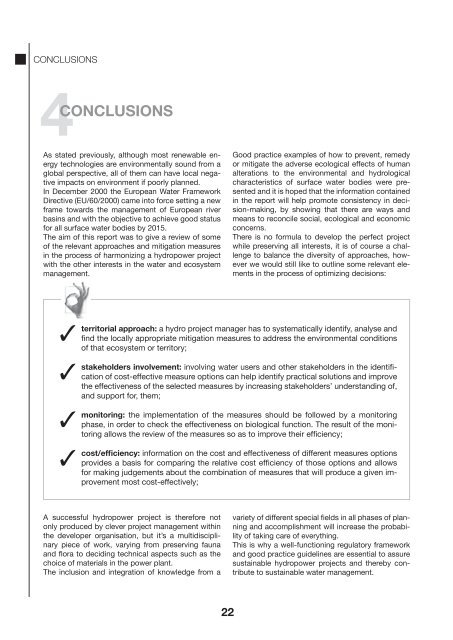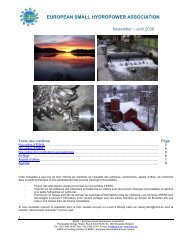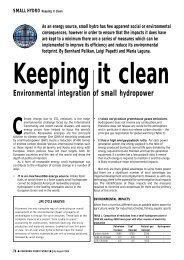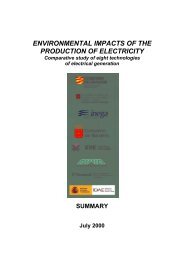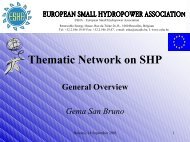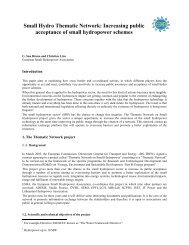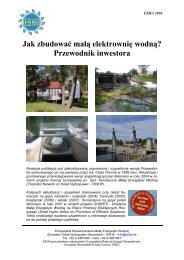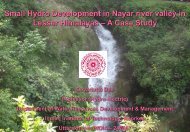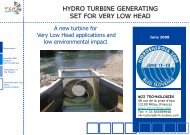HYDROPOWER AND ENVIRONMENT - ESHA
HYDROPOWER AND ENVIRONMENT - ESHA
HYDROPOWER AND ENVIRONMENT - ESHA
You also want an ePaper? Increase the reach of your titles
YUMPU automatically turns print PDFs into web optimized ePapers that Google loves.
CONCLUSIONS<br />
4CONCLUSIONS<br />
As stated previously, although most renewable energy<br />
technologies are environmentally sound from a<br />
global perspective, all of them can have local negative<br />
impacts on environment if poorly planned.<br />
In December 2000 the European Water Framework<br />
Directive (EU/60/2000) came into force setting a new<br />
frame towards the management of European river<br />
basins and with the objective to achieve good status<br />
for all surface water bodies by 2015.<br />
The aim of this report was to give a review of some<br />
of the relevant approaches and mitigation measures<br />
in the process of harmonizing a hydropower project<br />
with the other interests in the water and ecosystem<br />
management.<br />
✓<br />
✓<br />
✓<br />
✓<br />
territorial approach: a hydro project manager has to systematically identify, analyse and<br />
fi nd the locally appropriate mitigation measures to address the environmental conditions<br />
of that ecosystem or territory;<br />
stakeholders involvement: involving water users and other stakeholders in the identifi -<br />
cation of cost-effective measure options can help identify practical solutions and improve<br />
the effectiveness of the selected measures by increasing stakeholders’ understanding of,<br />
and support for, them;<br />
monitoring: the implementation of the measures should be followed by a monitoring<br />
phase, in order to check the effectiveness on biological function. The result of the monitoring<br />
allows the review of the measures so as to improve their effi ciency;<br />
cost/effi ciency: information on the cost and effectiveness of different measures options<br />
provides a basis for comparing the relative cost effi ciency of those options and allows<br />
for making judgements about the combination of measures that will produce a given improvement<br />
most cost-effectively;<br />
A successful hydropower project is therefore not<br />
only produced by clever project management within<br />
the developer organisation, but it’s a multidisciplinary<br />
piece of work, varying from preserving fauna<br />
and fl ora to deciding technical aspects such as the<br />
choice of materials in the power plant.<br />
The inclusion and integration of knowledge from a<br />
22<br />
Good practice examples of how to prevent, remedy<br />
or mitigate the adverse ecological effects of human<br />
alterations to the environmental and hydrological<br />
characteristics of surface water bodies were presented<br />
and it is hoped that the information contained<br />
in the report will help promote consistency in decision-making,<br />
by showing that there are ways and<br />
means to reconcile social, ecological and economic<br />
concerns.<br />
There is no formula to develop the perfect project<br />
while preserving all interests, it is of course a challenge<br />
to balance the diversity of approaches, however<br />
we would still like to outline some relevant elements<br />
in the process of optimizing decisions:<br />
variety of different special fi elds in all phases of planning<br />
and accomplishment will increase the probability<br />
of taking care of everything.<br />
This is why a well-functioning regulatory framework<br />
and good practice guidelines are essential to assure<br />
sustainable hydropower projects and thereby contribute<br />
to sustainable water management.


